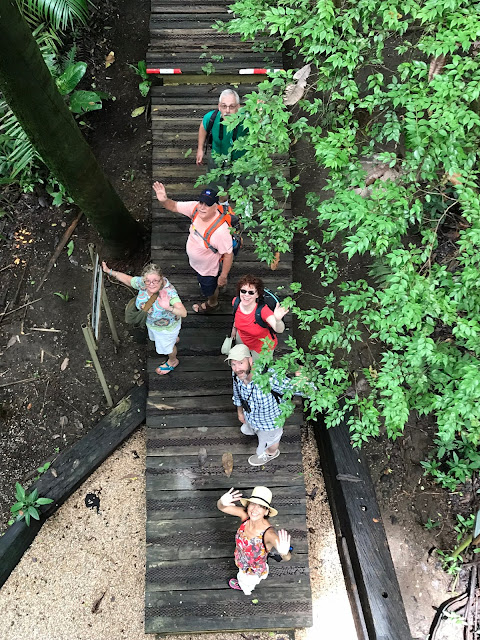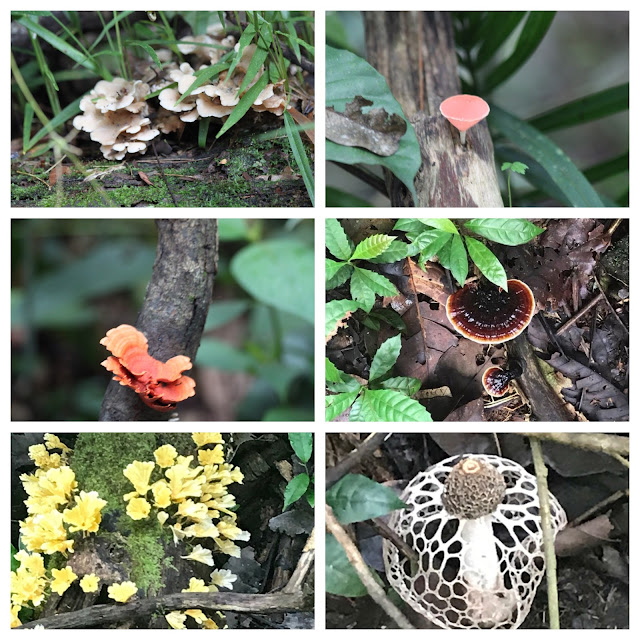
Our day began with a drive to the Chagras River. Anne Gordon
served as our guide, and shared stories about the Embera Indigenous Village we
were about to visit. Anne was a story in and of herself as we learned how she
met the Embera when she was working on a movie production called The Tip of the
Spear, fell in love with and married an Embera man, and came to live with and
help support the Embera. When asked what attracted him to her, she smiled and
said, “It was the light in his eyes.” Truly a remarkable story for a modern,
west coast woman to give up much of her comfortable way of life to move to
Panama and live a simpler life with the tribe. You can read more about her
story: http://www.emberavillagetours.com/anne-gordon-de-barrig-n.html
We reached a point in the journey where we needed to leave
our small bus and board 4-wheel drive pickup “taxis” with bench seats in the
back, that could traverse the muddy, narrow and winding terrain, which brought
us to the river’s edge.
At the
river we were greeted by Embera who came to pick us up in their long, wooden
canoes, carved out by hand from trees in the rainforest. Traditionally the
canoes were paddled and poled but today, with tourism as a way to sustain their
community, they use outboard motors. The man at the bow poles the boat when we
reach shallow water. Remarkable how they read the river to avoid the rocks and
fallen trees.
After 45
minutes of motoring through pristine rainforest, we approached the Embera
village, far from any road or modern town. Thatched huts along the banks of the
river. We were greeted with music by several Embera villagers.
We
gathered in their communal hall to meet the tribe, including the children, and
had an orientation to their way of life, translated by Ann. Many of the tribe
members we met were Ann’s in laws! They wore their typical dress, loin clothes
for men, bare chests for women, tattoos painted from a local seed, and skin
covered with a plant pigment to ward off insect bites. They also had beautiful
beaded adornments. The fabrics are made in Panama City but the designs are
created by Embera women. Very colorful! Everyone was so friendly and the
children were so curious. Families set up tables with their handicrafts which
we purchased. The Embera are especially known for their beautiful, tightly
woven baskets. They also make beautiful jewelry and several bracelets and
necklaces were purchased by our group.
The Embera children were adorable! Families are
very close knit and you could see the love the parents had for their children.
One little toddler had a meltdown while we were there. There are no cultural
differences when it comes to a toddler meltdown!

Thatched homes and a large thatched communal dining area where we had to climb up a ladder
Drying their washed fabrics used as wrap around skirts
After lunch we wandered freely throughout the
village and interacted with the children and families. Several of our group had
tattoos painted on their arms by the Embera women that will last for a couple
weeks. At one point it poured and it was fun watching the children run and play
in the rain. Bathroom breaks were taken in the communal privy.
The "Outhouse"
We brought donations of clothes, supplies, books
and things for the children. One book I brought was The Great Kapok Tree,
translated into Spanish which the children were delighted by as they recognized
many of the rainforest animals and would point and say, “Mira, mira, mira!”
Some went to visit the local school in the
village. Because it is funded by the Panamanian government, the children are
required to wear uniforms. The teacher was very engaged with the students, who
was teaching about time. They made a cardboard clock. Luiza, our middle school
classroom teacher, said, “I loved seeing the children eating their lunches.
They were very happy. “ She saw workbooks similar to ones we use in the states.
The classrooms were simple but invited learning. They had a solar panel just outside
the building to help power the fans in the classrooms. The teacher from Panama
City was appointed by the government and lived in the village during the weekdays.
Luiza, the classroom teacher in our group, visits the school
Before we
left we were treated to a performance of traditional dances - the monkey dance
and the jaguar dance. Enjoy the video!
The finale was when we all got to dance together, starting
with Frank who was the first from our group to be selected as an Embera dance
partner!
Upon our departure, Caroline, who had a sore throat, was
treated by an Embera woman with a rich knowledge of medicinal plants. She
brewed a special elixer for Caroline so she would feel better!
We said goodbye to these wonderful people who
live so simply with few of the amenities of modern life yet they are truly
“rich” and certainly enriched our experience in Panama.
That evening we had a lovely group dinner at the Gamboa Resort. Time for some make bonding among the group, our guide Claudio, and our driver, Daniel!
That evening we had a lovely group dinner at the Gamboa Resort. Time for some make bonding among the group, our guide Claudio, and our driver, Daniel!



























































